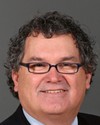Good morning, ladies and gentlemen. How are you?
My name is Hubert Noël and I'm originally from Lamèque, New Brunswick.
I belong to a family of white crab fishermen. I've been doing this job for 20 years. The announcements in the spring gave me the impression of going back 20 years. I'm part of the new generation. As a result of the political decisions such as the announcement on March 8, in which the Minister of Fisheries and Oceans maintained the fishing effort at approximately 400 boats, I no longer know what kind of future I can anticipate as a father.
In the last collapse, in 1989-1990, we had 130 boats facing the challenge of increasing and stabilizing that resource. We managed to do it by investing tens of millions of dollars in cooperation with DFO. In 2003, the federal government thanked the traditional crab industry for investing millions of dollars and for properly managing and protecting the resource, but notified it that the surpluses generated wouldn't fall to it. They would go to fishermen with so-called problems in other fishing industries.
I dared to believe that Canada was a country where a free enterprise employing five or six individuals was entitled to be viable and prosperous. Don't forget that crab and lobster aren't inextricably connected, in our case. If we hold a licence for area 12, we aren't entitled to hold other licences, for lobster, scallops or herring, for example, which are the private preserve of the inshore fleets.
Now I'd like to tell you about my fears about the unexplained losses—according to the scientists with the trawl raft. This is very important. On the first page of the documents, reference is made to commercial biomass that was harvested for 2009, that is 44,700 tonnes. That doesn't count juveniles, females, small fish or babies. These are all crabs of 95 mm or more, with big claws. This is real commercial crab.
In the other column, it states that 20,900 tonnes were fished. According to the survey subsequently conducted, approximately 25,000 tonnes should have been left in the sea, but only 9,300 tonnes were found. That means that 14,500 tonnes were lost. We don't know where they are. They disappeared. Did someone steal them? We don't know.
The second page deals with annual estimated crab losses in area 12 since 1998. As you can see, those losses have been significant. Two thousand and five was a very good year for crab. The tonnage was high in the gulf. We didn't find 26,000 tonnes. That's equal to the total biomass for this year. In 2005, we lost that.
In the first column on the last page, it states that the quota landed by traditional crab fishermen was 13,622 metric tonnes, which made it possible to operate the entire traditional fleet and the plants in New Brunswick and Quebec. The entire industry operated on that last year. This year, we're told we've lost 14,500 tonnes. That's equal to last year's production, and even more. That means that there is a problem with the survey and with the scientists. We have to ask ourselves some questions.
Thank you for listening to me. I hope some light will be shed on all of DFO's actions. If you have any questions, I can answer them.



